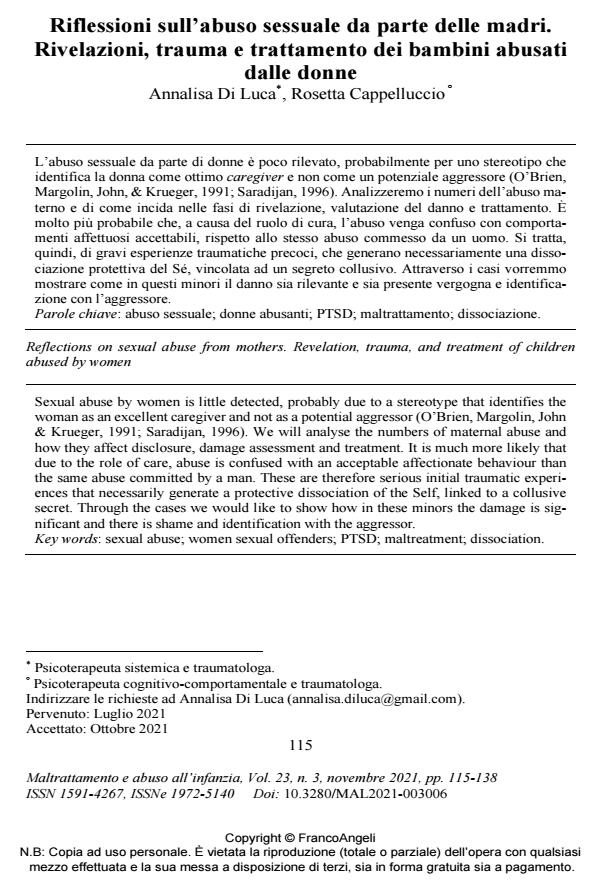Riflessioni sull’abuso sessuale da parte delle madri. Rivelazioni, trauma e trattamento dei bambini abusati dalle donne
Titolo Rivista MALTRATTAMENTO E ABUSO ALL’INFANZIA
Autori/Curatori Annalisa Di Luca, Rosetta Cappelluccio
Anno di pubblicazione 2021 Fascicolo 2021/3
Lingua Italiano Numero pagine 24 P. 115-138 Dimensione file 244 KB
DOI 10.3280/MAL2021-003006
Il DOI è il codice a barre della proprietà intellettuale: per saperne di più
clicca qui
Qui sotto puoi vedere in anteprima la prima pagina di questo articolo.
Se questo articolo ti interessa, lo puoi acquistare (e scaricare in formato pdf) seguendo le facili indicazioni per acquistare il download credit. Acquista Download Credits per scaricare questo Articolo in formato PDF

FrancoAngeli è membro della Publishers International Linking Association, Inc (PILA)associazione indipendente e non profit per facilitare (attraverso i servizi tecnologici implementati da CrossRef.org) l’accesso degli studiosi ai contenuti digitali nelle pubblicazioni professionali e scientifiche
L’abuso sessuale da parte di donne è poco rilevato, probabilmente per uno stereotipo che identifica la donna come ottimo caregiver e non come un potenziale aggressore (O’Brien, Margolin, John, & Krueger, 1991; Saradijan, 1996). Analizzeremo i numeri dell’abuso ma-terno e di come incida nelle fasi di rivelazione, valutazione del danno e trattamento. È molto più probabile che, a causa del ruolo di cura, l’abuso venga confuso con comportamenti af-fettuosi accettabili, rispetto allo stesso abuso commesso da un uomo. Si tratta, quindi, di gravi esperienze traumatiche precoci, che generano necessariamente una dissociazione pro-tettiva del Sé, vincolata ad un segreto collusivo. Attraverso i casi vorremmo mostrare come in questi minori il danno sia rilevante e sia presente vergogna e identificazione con l’aggressore.
Parole chiave:abuso sessuale; donne abusanti; PTSD; maltrattamento; dissociazione
Annalisa Di Luca, Rosetta Cappelluccio, Riflessioni sull’abuso sessuale da parte delle madri. Rivelazioni, trauma e trattamento dei bambini abusati dalle donne in "MALTRATTAMENTO E ABUSO ALL’INFANZIA" 3/2021, pp 115-138, DOI: 10.3280/MAL2021-003006